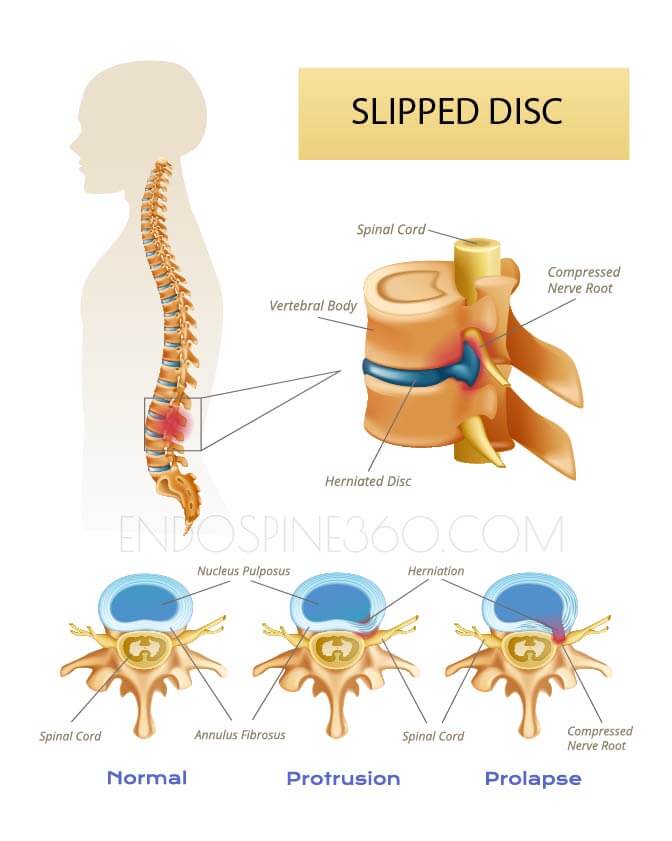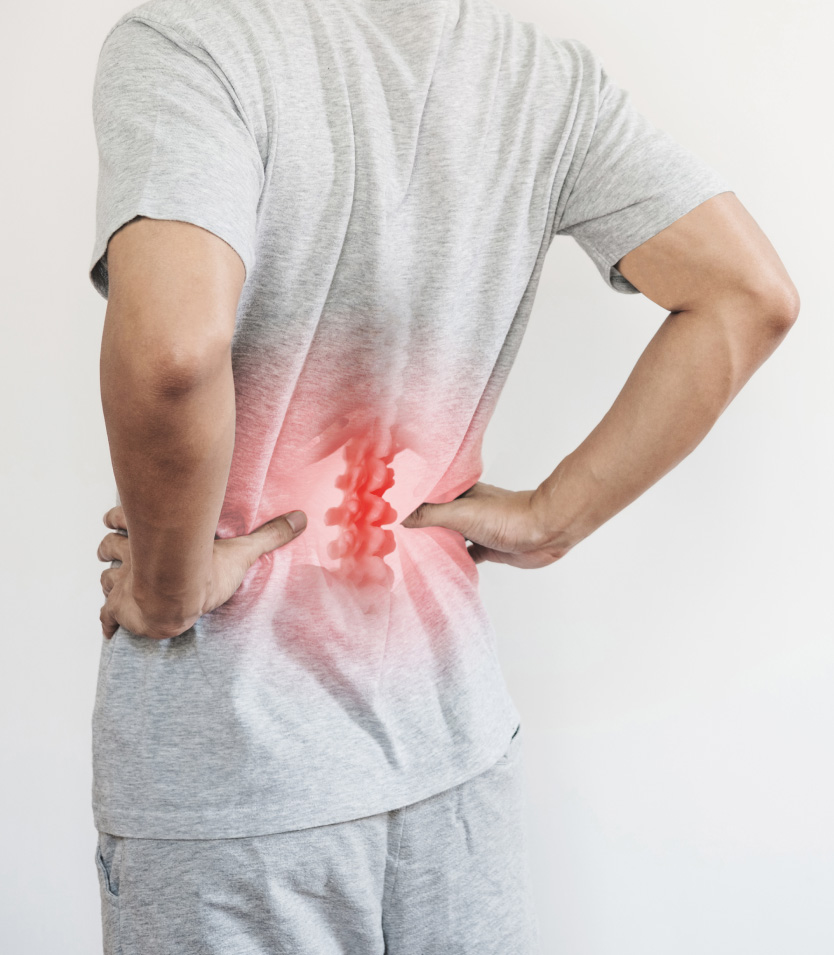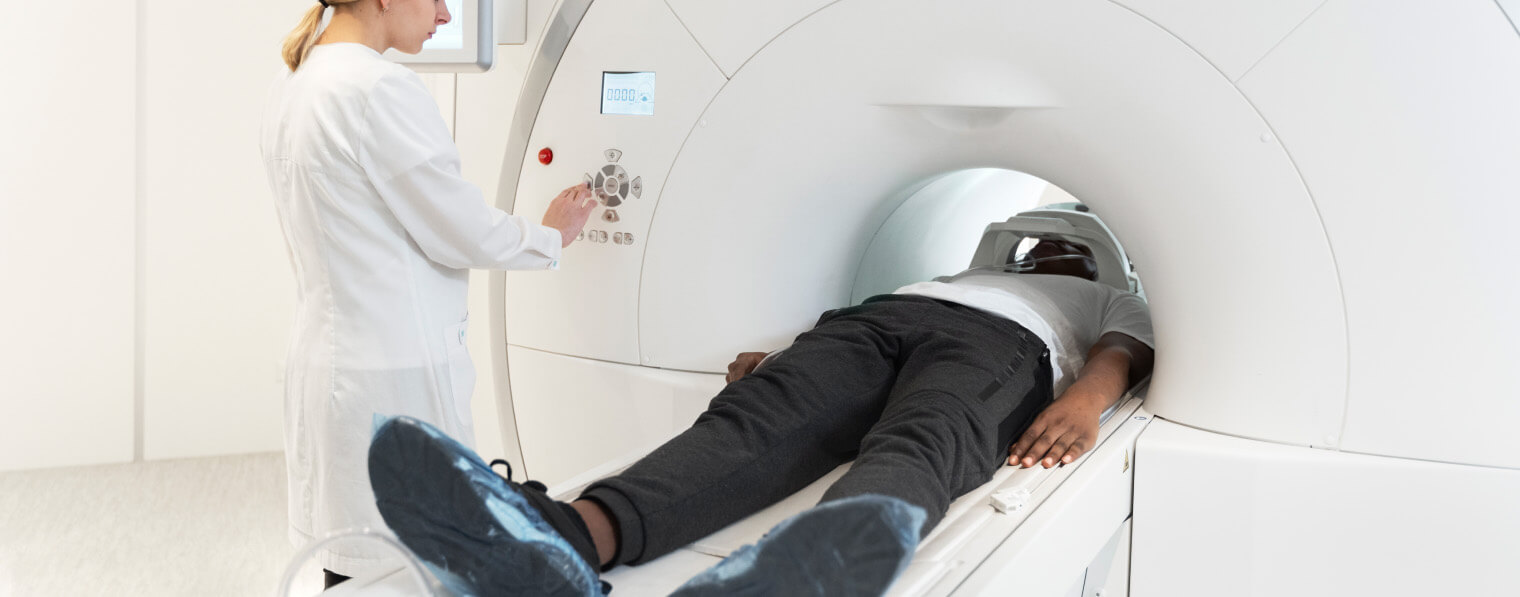Slipped or Herniated Disc
Slipped disc is a condition when the soft cushion of tissue (also called disc) between the bones in your spine pushes out or protrudes. It is also called Herniated disc, Disc bulging, or ruptured disc. It's painful if it presses on nerves. A herniated disc can occur in any part of the spine but most often it occurs in the lower back of the spine. Depending on the location, it can result in pain, numbness, or weakness in an arm or leg.

Research says, between 60 to 80% of people experience low back pain at some point in their lives for different reasons. Sipped disc is one of the most common causes of back pain.
Know more about Slipped Disc Symptoms, Slipped Disc Causes, Slipped Disc Diagnosis, and Slipped Disc Treatment Options
Slipped Disc Symptoms
In the condition of Slipped Disc or Herniated Disc, many people may have no symptoms at all. For people who do have symptoms, the symptoms tend to enhance over time. As we mentioned before, in most cases herniated disks occur in the lower back, but they can also occur in the neck or cervical reason. Symptoms completely depend on the location of the disc and whether the disc is pressing the nerve. Usually, it affects one side of the body (left side or right side), again depending on the nerve it is pressing.
Symptoms of a slipped disc include

- Pain and numbness on arms/legs
- Pain that worsens at night
- Pain when walking short distances
- Pain in specific movements
- Burning sensations or tingling sensations on the area innervated by the affected nerves
- Weak muscles in the area served by the affected nerves
- In rare cases loss of bladder or bowel control.
Know more about Slipped Disc, Slipped Disc Causes, Slipped Disc Diagnosis, and Slipped Disc Treatment Options
Slipped Disc Causes
A herniated or slipped disc occurs when a spinal disc slips out and presses nearby nerve. Most commonly occurs in the lower back but can also happen in the neck and middle back.
Here are the most common causes of herniated, ruptured, or slipped discs:
Age-related Degeneration: With age, the spinal discs lose water content. In older people, spinal disks become drier and weaker which makes the disc more likely to herniate.
Obesity or Weight: Excess weight puts extra pressure on the discs, making them more prone to disc herniation.
Occupational: Certain professions are physically demanding and involve heavy lifting or repetitive motions. These occupations increase the risk of disc herniation.
Genetics: Some individuals may be predisposed to disc problems due to genetic factors.
Smoking: Smoking can reduce blood flow to the spinal discs, reducing the oxygen supply to discs, which impacts their ability to heal and recover from injury.
Trauma or Injury: During accidents or falls, disc herniation can occur.
Lifestyle Factors: Sedentary lifestyle, poor posture, and lack of regular exercise weakness in the back muscles can contribute to disc issues.
Degenerative Disc Disease: DDD is a condition characterized by the gradual breakdown of the spinal discs over time, leading to disc herniation. Know more about Degenerative Disc Disease
Cauda Equina Syndrome: The collection of nerves at the end of the spinal cord is called the cauda equina because it looks like a horse's tail. Cauda equina syndrome or CES occurs when the nerve roots of the cauda equina are pressed which may disrupt motor and sensory function to the lower extremities and bladder.
Know more about Slipped Disc, Slipped Disc Symptoms, Slipped Disc Diagnosis, and Slipped Disc Treatment Options
Slipped Disc Diagnosis
The diagnosis of a herniated disc generally requires a comprehensive approach, including a detailed medical history, a thorough physical examination, and the use of advanced imaging tests.
Physical examination:
During the physical examination, your spine doctor will check your back for tenderness and may also perform a neurological examination to check your:
- Reflexes
- Muscle strength
- Walking ability
- Ability to feel pinpricks and or vibration
In the majority of the cases of Slipped discs, your medical history and physical examinations are all that's needed but if your doctor or sciatica consultant wants to check further on which nerves are being pressed or any other detailed information is needed then the following tests are required:
Imaging Tests:

X-rays: X-rays provide a basic view of the spine, showing the alignment of vertebrae and any signs of arthritis or bone spurs. While X-rays cannot directly show herniated discs, they can help rule out other spinal conditions.
Magnetic Resonance Imaging (MRI): An MRI provides detailed images of the soft tissues in the spine, including the discs and nerves. MRI is used to confirm the location of the slipped disc and identify which nerves are affected.
Computed Tomography (CT) Scan: In a CT Scan, a series of X-rays are taken from different directions.
Myelogram: Myelography involves injecting a contrast dye into the spinal canal to provide a clearer visualization of the spinal cord, nerve roots, and surrounding structures. The dye helps highlight any abnormalities or areas of compression that may be causing your symptoms.
Nerve tests: are performed to help diagnose a slipped disc (herniated disc) and assess its impact on the surrounding nerves. Two common nerve tests used in this diagnostic process are Electromyography (EMG) and Nerve Conduction Studies (NCS). EMC and nerve conduction studies measure how well electrical impulses are moving along nerve tissue. This can help pinpoint the exact location of nerve damage.
Know more about Slipped Disc, Slipped Disc Symptoms, Slipped Disc Causes, and Slipped Disc Treatment Options
Slipped Disc Treatment
For some patients, a herniated lumbar disc will slowly improve over a period of time. However, most of the patients need medication and further consultation from a Slipped disc doctor.
Below are a few treatment options for Slipped disc patients:
Non-Surgical Treatment for Slipped Disc
Initial treatment for a herniated disc is usually nonsurgical which may include:
- Rest
- Applying Heat or Cold
- Massage
- Physical Therapy
- Oral Medications
- Non-Steroid Anti-Inflammatories (NSAIDs)
- Epidural steroid injections
Surgical Treatment for Slipped Disc
Spine surgery is recommended only after a period of time when nonsurgical treatments have not relieved painful symptoms, or for patients who are experiencing the problem of weakness, problem in walking or loss of bladder or bowel control. The following are surgical options for Slipped disc condition:
- Transforaminal Endoscopic Lumbar Discectomy
- Interlaminar Endoscopic Lumbar Discectomy
- MicroLumbar Discectomy
- Nucleotomy
- Laminectomy
- Spinal fusion
- Disc replacement
Know more about Slipped Disc, Slipped Disc Symptoms, Slipped Disc Causes, and Slipped Disc Diagnosis, Options



